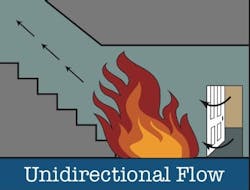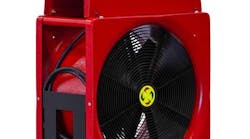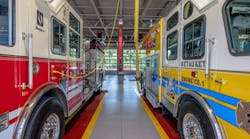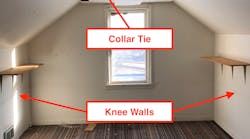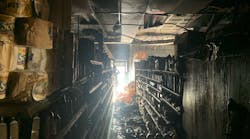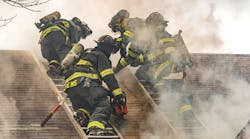Any experienced firefighter or officer will tell you that firefighting requires dedication to drilling and learning. For good reason, hands-on drills that are performed in the fire station are front and center in this dedication. It also is important to understand our adversary. Many firefighters have a good understanding of the general concepts. Moving beyond the general toward specific situations that can occur increases preparedness.
Below-grade fires (fires that occur in cellars or duplex-down apartments) present unique challenges. Understanding the ways that fire behaves in these situations increases the chances of success.
Flow path
In recent years, the firefighting community learned a great deal about the various types and behaviors of flow path at structural fires. This isn’t to say that flow path, in its many forms, didn’t exist in the fires of yesteryear. Rather, the types of materials that burn today (synthetic petroleum-based plastics, etc.) result in fires that become much hotter, much faster, thereby intensifying the effects of flow paths much sooner. What’s more, our ability to monitor and identify differing flow paths has improved as technology has.
In short, most structural fires result in one of three types of flow (within a flow path): bidirectional flow (the movement of higher-pressure heat and smoke out of the top of a single ventilation point while fresh air is drawn in on the bottom), unidirectional flow (the intake of fresh air that moves toward the fire from one direction, while heat and smoke move away from the fire through another ventilation point in another direction; and dynamic flow (the alternating movement of higher-pressure heat and smoke in and out of a ventilation point that’s caused by either the equalization of pressure inside of the structure or intermittent ventilation from the opposite direction). All three types present their own challenges, but unidirectional flow (particularly when it occurs suddenly) creates a uniquely dangerous situation for firefighters. When unidirectional flow occurs suddenly at a below-grade fire, the result often is deadly.
Firefighter deaths
Two examples of the potentially deadly effects of sudden unidirectional flow occurred in New York City in 2005 and in Boston in 2014. A basement fire in a Brooklyn private dwelling took the life of Firefighter Richard Sclafani; a Brownstone basement fire in Boston killed Lt. Edward Walsh and Firefighter Michael Kennedy. All three men were killed while they attacked the fire via interior basement stairs while uncoordinated ventilation (both spontaneous self-venting and the intentional opening of doors and windows) occurred in exterior basement doors and windows.
Investigating the Boston fire, National Institute for Occupational Safety and Health concluded that, because the doors on the Charlie side were left open or failed, the interior doors at the top of the basement steps were left open and the front doors on the Alpha side were left open by an occupant who fled the fire, an unrestricted flow path was created from the basement to the first floor and to the floors above.
In both cases, the efforts to rescue the men by other firefighters who were on scene were heroic, but the intensity of the heat that was generated by these unidirectional flows was insurmountable. In both cases—in addition to doors that were opened intentionally—there were windows that self-vented. If the overriding theme is that coordinating ventilation is vital, it’s important to remember that not all ventilation is within our control.
Below-grade areas
There are numerous types of below-grade occupancies. Private dwellings and apartment buildings have basements. Commercial occupancies have lower levels and cellars. Some condominium units have duplex-down apartments, which often results in a “cellar fire in the sky.”
Some basements offer little or no exterior ventilation, and others have windows and/or doors, including sliding glass doors and configurations known as “walk-out basements.”
Different departments have different tactics for these types of fires, but whatever your department’s standard operating procedures, coordination between interior and exterior personnel is vital, and ventilation must be coordinated.
In 2018, Underwriters Laboratories (UL) conducted a series of experiments that recorded the effects of ventilation at basement fires. One set of burns documented conditions, first with a basement exterior sliding glass door closed and then with the door opened after three minutes and 40 seconds. At the top of the interior stairs, heat temperature and velocity were recorded 11 inches below the ceiling. With the sliding glass door closed, the peak temperature was 360 degrees Celsius, and peak velocity was 3.5 m/sec. With the sliding glass door opened, peak temperature was 960 degrees C, and peak velocity was 7.5 m/sec.
Often, the intense movement of superheated air and fire toward the interior stairs is aided by high winds that are occurring outside of the opposing vent point. However, unlike unidirectional flow situations in fireproof high-rise buildings, where the combination of an open window, apartment door and stairwell door might cause a unidirectional flow when high winds are present, the movement of higher-pressure heat and smoke up the stairs can occur in vented below-grade fires with or without high winds. The rising nature of heated air creates the unidirectional flow up the stairs independent of wind pressure from the opposite direction. This phenomenon is sometimes referred to as “low-intake, high-exhaust flow path.” That said, high winds still can intensify the flow.
Interior stairs
Utilizing the interior stairs for hoseline access to the basement protects the upper levels and occupants who are above the fire, but there’s the potential for either an untenable stairway down, by which firefighters can’t advance a hoseline, or a sudden unidirectional flow path if the basement is suddenly vented from the exterior. If such an interior attack is initiated, exterior ventilation of the below-grade area must be controlled until the fire is knocked down.
Some private dwellings have rear yards that are lower than the front of the dwelling, with sliding doors accessing the basement, in addition to interior stairs. Others have dugout stairwells or window wells accessing the basement. Exterior firefighters must coordinate the ventilation of these features with interior firefighters. It’s the uncoordinated ventilation of these doors and windows that causes the unexpected unidirectional flow of higher-pressure heat, smoke and fire up the interior basement stairs. Firefighters who already are committed to these stairs will be caught directly in the exhaust of the flow path.
Exterior entrances
Some departments might utilize exterior basement doors as the primary hoseline access way. Again, coordination is key. In this situation, interior firefighters must be aware that the primary attack is being initiated from the exterior and that the interior basement stairs now might be endangered. Isolating these stairs (perhaps closing a door at the top of the stairs) can help to protect firefighters and occupants on the upper levels. The presence of an exterior door to the basement is a crucial part of size-up.
Operating and/or advancing a hoseline through an exterior basement entrance ensures water on the fire quickly. There’s potential for redirecting the flow path of heat, fire and smoke to the upper floors (where occupants and other firefighters might be endangered) but not from the application of water itself.
In 2012, FDNY, in conjunction with UL and National Institute of Standards and Technology, conducted a series of live burn experiments at a complex of vacant buildings on Governors Island, NY. Applying water directly on a basement fire through an exterior opening had the immediate effect of greatly reducing temperatures throughout the basement, interior stairs and rooms above; it didn’t push fire up the stairs. Increased risk comes from a unidirectional flow that’s created when the basement exterior door is opened (if the interior basement door is also opened) and water isn’t applied to the fire within a few seconds. Of course, if the basement exterior opening in question already is vented, the point is moot.
When operating a hoseline through an exterior opening into an occupied structure, directing the stream at a high angle into the opening—so the contact point of water is the ceiling just inside of the opening—coats the entire ceiling area of that room with water and disrupts the heat flow immediately. This lessens the chances of creating a detrimental flow in other parts of the structure. UL noted in conjunction with one of its studies that, as water through the stream flows through air, it displaces air that’s in front of it, which creates lower pressure air behind the water and pulls air along its path. UL refers to this effect as entrainment. Furthermore, the longer the distance that a hose stream travels before it hits a surface (stream length), the more air the stream will entrain, UL said.
Directing the hose stream at a high angle, just inside of the opening, shortens the length of the stream, which lessens the amount of fresh air that the stream itself gives to the fire. This tactic is beneficial, as an option, when operating an exterior stream while occupants and firefighters are still inside of a structure, for a quick emergency knockdown. Just 15 seconds of flowing water greatly reduced temperatures during the Governors Island experiments.
Entrainment also is increased by nozzle movement (e.g., “O” or “Z” patterns). Of course, nozzle movement often is the desired effect in standard hoseline advancement. However, when occupants and firefighters are inside of the structure, holding the nozzle of an operating exterior hoseline in a fixed position limits entrainment.
Basement conditions might affect the application of exterior streams. For example, heavy clutter could block windows, and basement ceilings might not be finished (exposed joists). These conditions could diminish water distribution from a deflected stream, though in the case of an open ceiling, the exposed joists would benefit from being cooled down, water spray still would disperse (albeit, perhaps, not as far) and, most importantly, the chances of negatively affecting the flow path up the interior stairs aren’t increased.
Lesson learned
In 2003, I was a firefighter who was assigned to a Squad Company. We responded to a fire in a fireproof high-rise building that had down-duplex apartments. The fire originated in the lower level of an upper-floor apartment—the dreaded “cellar fire in the sky.”
The first-due engine company’s officer, nozzleperson and backup firefighters received serious burns when the lower-level windows vented and caused severe conditions on the stairs. The lieutenant and a firefighter from my company took control of the hoseline, while another firefighter and I hooked up to another standpipe outlet and stretched a hoseline to the adjacent apartment.
Duplex apartments that were in this complex were staggered in a “Z” configuration, with the upper levels and lower levels facing opposite frontages. Consequentially, finding the right apartment to lead the additional hoseline to an abutting wall took some time.
Once in place, the firefighter who was with me broke a small hole in the wall to confirm, and we could see the fire on the other side.
I bled the hoseline of air and prepared to operate through the wall. My colleague attempted to call our lieutenant on the radio to coordinate before committing to fully breaching the wall. However, before his transmission was answered, we heard the hoseline on the other side of the wall operating and saw the fire through the inspection hole turn to steam.
The lieutenant and firefighter on the first hoseline finally were able to advance down the stairs, but not without being burned themselves. The hoseline that my colleague and I stretched into the adjoining apartment was never used.
Advancing the first hoseline directly down the interior stairs was the principally taught tactic for below-grade fires in my department at that time, and the fire service only just began to understand flow path. Even if my colleague and I were able to have that additional hoseline in place sooner, we probably would have waited until the lieutenant and firefighter on the first hoseline were backed out of the apartment (a time-consuming undertaking) before operating. I most likely would have opened the nozzle and directed the stream directly (almost horizontally) into the breach opening.
If we knew then what we know now, a quick radio transmission to the lieutenant could have held him and the other firefighter at the top of the stairs momentarily, while I opened the nozzle through the breach, pointing the stream directly at the ceiling, almost straight up inside of the hole. Twenty seconds of water from that angle would have been enough to temporarily disrupt the heat flow and cool the area. I then could have shut my nozzle, and the lieutenant and firefighter would have brought their hoseline down the stairs for full extinguishment and not gotten burned.
Know your district
Another crucial piece of the dedication to drilling and learning is knowing the buildings that are in your district. The presence of interior stairs and exterior doors to cellars in private dwellings, for example, is great information to have ahead of time, if possible. Together with time of day, presence of occupants, and location and severity of fire, this information helps with the decision of where to position the first hoseline.
Whether you serve in a paid or volunteer department, professionalism is a standard toward which you should aspire. An aggressive interior attack is crucial to saving lives at fires in occupied structures. Having a working understanding of fire behavior and flow paths is a key component of any interior attack and leads to better coordination and increased professionalism—with the ultimate goals of increased safety and improved chances of success.
